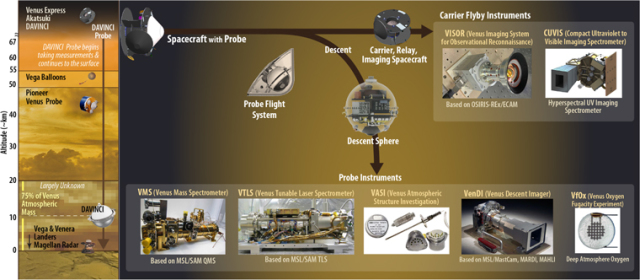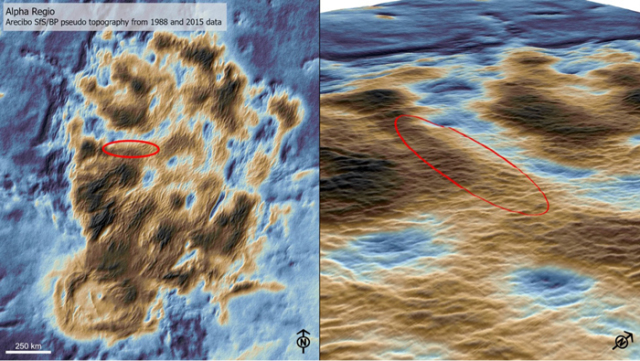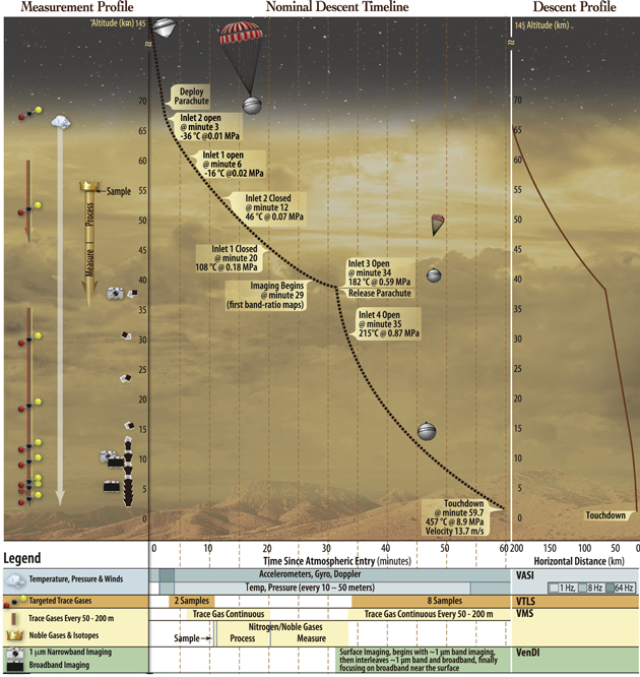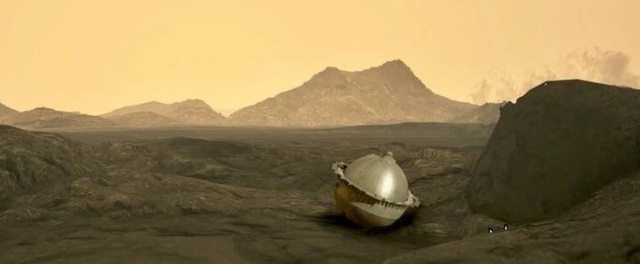The DAVINCI project team, which will study the atmosphere and surface of Venus, has published a detailed work plan. It is expected that the spacecraft will be launched into space in 2029, and the descent probe will enter the atmosphere of Venus in the summer of 2031, where it will work for more than an hour, reaching the surface of the planet in the area of Tessera Alpha. The article about is published in the journalThe Planetary Science Journal.
DAVINCI and the automatic VERITAS station were selected by NASA to implement the Discovery program. The project involves the creation of an orbital repeater probe and a descent atmospheric probe, which should be launched and sent to Venus in June 2029. The collected data should help answer a number of questions about the origin of the planet's atmosphere and its evolution, the difference between Venus and other terrestrial planets, confirmation of the existence of an ocean on its surface in the past and current active volcanism. DAVINCI should also provide detailed information about the composition of the atmosphere, the chemical and physical processes taking place in the clouds and lower layers of the atmosphere and the properties of the surface of Venus.
A group of NASA scientists and engineers led by James B. Garvin, a leading scientist of the DAVINCI project from the Goddard Space Flight Center, published a detailed plan for exploring the atmosphere and surface of Venus using a descent and flyby probe.

The general plan of the mission.
Image source: James B. Garvin et al. / The Planetary Science Journal, 2022

List of scientific instruments installed on probes.
Image source: James B. Garvin et al. / The Planetary Science Journal, 2022

Device of the DAVINCI descent probe.
Image source: James B. Garvin et al. / The Planetary Science Journal, 2022
Six months after launch, the CRIS orbiter will make a close flyby of Venus, conducting a remote study and spectroscopy of the clouds of Venus in the ultraviolet range on the day side and mapping the emissivity of the planet's surface in the near infrared range on the night side. In November 2030, the second flight will be completed, during which much attention will be paid to observations of mountainous areas such as Tesserae and Mount Maat. Then, after another 7 months, the orbiting probe will visit Venus for the third time and on June 21, 2031, the descent probe should drop into the atmosphere of the planet.

Topographic map of the Alpha region based on radar data. The landing ellipse for the descent probe is marked in red.
Image source: James B. Garvin et al. / The Planetary Science Journal, 2022
The mountainous area was chosen as the work area Alpha region in the southern hemisphere of the planet near the equator. It represents a unique type of geological objects characteristic of Venus — tesserae . The major axis of the landing ellipse for the descent probe is about 310 kilometers, and it is located near the top of the ridge, about 900 meters high.
The descent module will be a sealed spherical titanium shell measuring 0.98 × 0.85 meters and weighing about 200 kilograms. The payload of the descent probe will consist of a VMS mass spectrometer, a Venus VTLS laser spectrometer, a VASI instrument designed to determine environmental parameters, a VenDI infrared camera and a VfOx oxygen sensor. The CRIS orbital probe will be equipped with two instruments: a VISOR imaging system containing four cameras and a CUVIS spectrometer.

A detailed plan for the descent of the probe in the atmosphere of Venus.
Image source: James B. Garvin et al. / The Planetary Science Journal, 2022
After entering the atmosphere and opening the parachute at an altitude of about 70 kilometers, the descent probe will reset the heat shield and begin collecting information about the content of various gas components in the environment, including noble gases, as well as assess the dynamics of the isotopic composition of the atmosphere, its temperature, pressure and wind strength depending on altitude and begin to observe the surface planets. It is expected that the sharpest images will have a resolution of less than 50 centimeters per pixel. All received data will be transmitted to the CRIS probe, which will then send them to Earth. Landing on Venus is expected in 57.04–66.7 minutes after the moment of separation from the orbital probe, if it passes safely, the probe can work on the surface of the planet for another 17-18 minutes before it shuts down.
In addition to DAVINCI, the European EnVision orbital station, the Indian automatic apparatus and the Russian Venera-D station, which we wrote about in the material and blog, will explore Venus in the near future.
Alexander Voityuk

